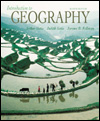 |  Introduction to Geography, 8/e Arthur Getis,
San Diego State University
Judith Getis
Jerome D. Fellmann,
University of Illinois, Urbana-Champaign
Population Geography
Objectives:After reading and studying this chapter you should be able to:
1.
Define the various measures basic to the analysis of population.
|
 |  |  | 2.
Construct a population pyramid from data on age and sex of a population.
|
 |  |  | 3.
Understand the cultural and physical factors which account for the geographic distribution of fertility,
mortality and natural increase.
|
 |  |  | 4.
Determine any country's position in the demographic transition from knowledge of its birth and death rates
and population growth rates.
|
 |  |  | 5.
Identify the differences in population growth characteristics between the developed world and the developing
world.
|
 |  |  | 6.
Discuss the affects of HIV/AIDS on population growth rates in developing countries.
|
 |  |  | 7.
Locate on a map the most densely populated and least densely populated areas of the world and explain their
geographic distribution.
|
 |  |  | 8.
Distinguish between areas that are overpopulated and those that are not based on carrying capacity.
|
 |  |  | 9.
Describe the relationship between urbanization and population growth and density.
|
 |  |  | 10.
Discuss population controls over time. Differentiate between natural population controls and artificial controls.
|
 |  |  | 11.
Evaluate Malthusian concepts of population growth in light of twentieth-century knowledge about
demographic processes.
|
 |  |  | 12.
Define population momentum and describe its implications for future population growth.
|
 |  |  | 13.
Understand the stages of the demographic transition model and be able to apply to present-day areas of the world.
|
|



 2002 McGraw-Hill Higher Education
2002 McGraw-Hill Higher Education